sensor TOYOTA BZ4X 2022 (in English) Manual PDF
[x] Cancel search | Manufacturer: TOYOTA, Model Year: 2022, Model line: BZ4X, Model: TOYOTA BZ4X 2022Pages: 674, PDF Size: 120.02 MB
Page 350 of 674
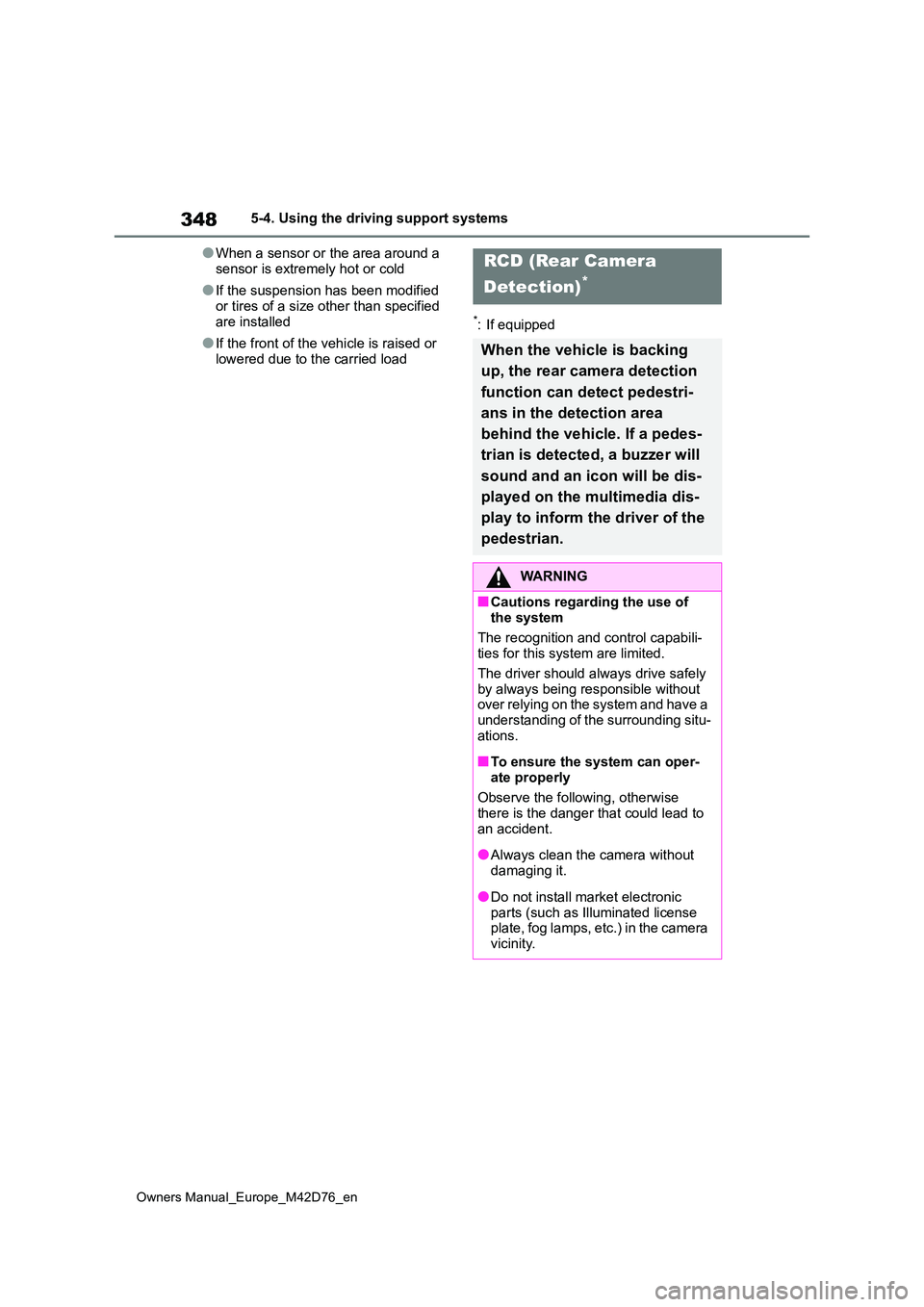
348
Owners Manual_Europe_M42D76_en
5-4. Using the driving support systems
●When a sensor or the area around a
sensor is extremely hot or cold
●If the suspension has been modified
or tires of a size other than specified are installed
●If the front of the vehicle is raised or lowered due to the carried load
*: If equipped
RCD (Rear Camera
Detection)*
When the vehicle is backing
up, the rear camera detection
function can detect pedestri-
ans in the detection area
behind the vehicle. If a pedes-
trian is detected, a buzzer will
sound and an icon will be dis-
played on the multimedia dis-
play to inform the driver of the
pedestrian.
WARNING
■Cautions regarding the use of the system
The recognition and control capabili- ties for this system are limited.
The driver should always drive safely
by always being responsible without over relying on the system and have a understanding of the surrounding situ-
ations.
■To ensure the system can oper-
ate properly
Observe the following, otherwise there is the danger that could lead to
an accident.
●Always clean the camera without
damaging it.
●Do not install market electronic
parts (such as Illuminated license plate, fog lamps, etc.) in the camera vicinity.
Page 352 of 674
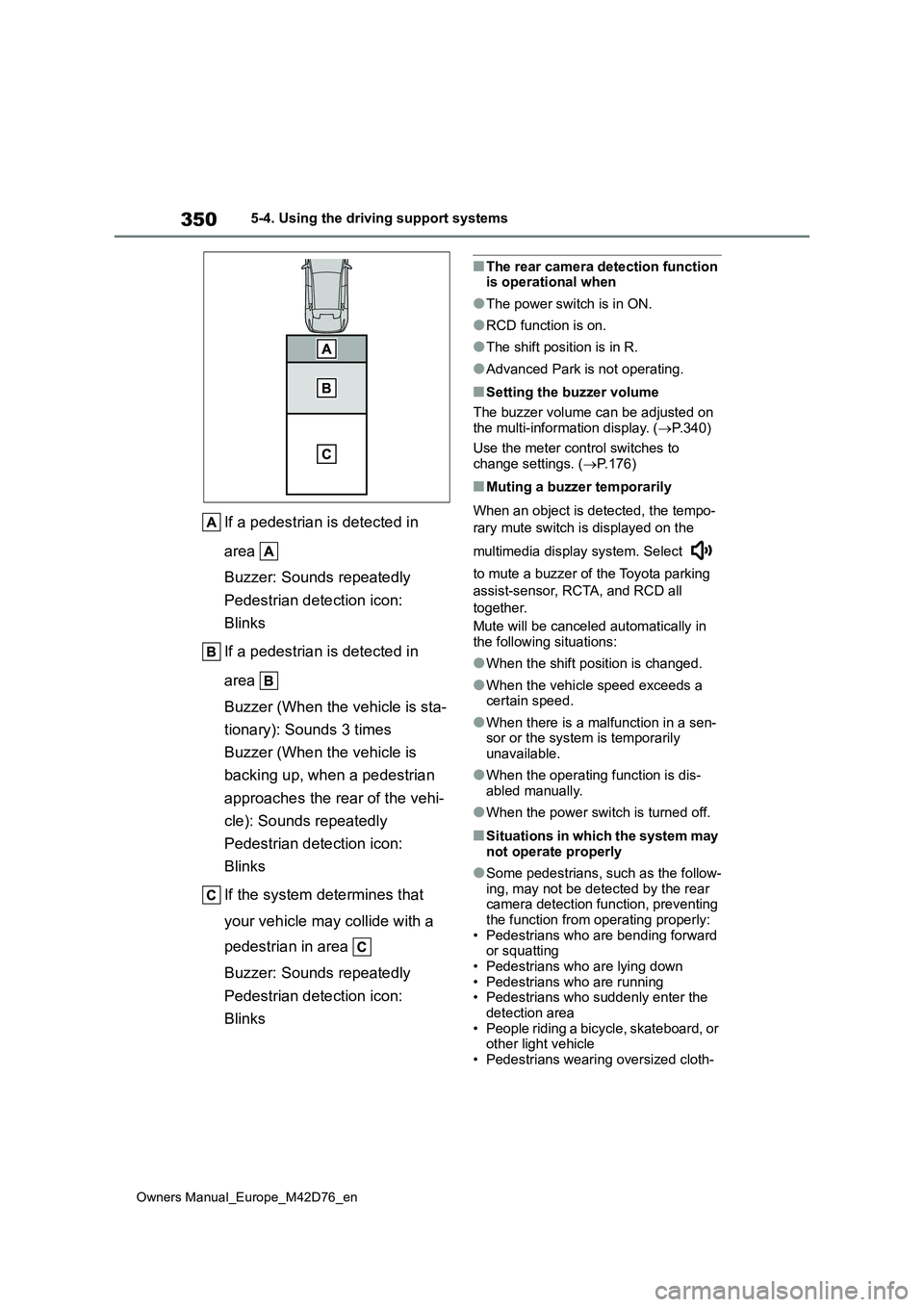
350
Owners Manual_Europe_M42D76_en
5-4. Using the driving support systems
If a pedestrian is detected in
area
Buzzer: Sounds repeatedly
Pedestrian detection icon:
Blinks
If a pedestrian is detected in
area
Buzzer (When the vehicle is sta-
tionary): Sounds 3 times
Buzzer (When the vehicle is
backing up, when a pedestrian
approaches the rear of the vehi-
cle): Sounds repeatedly
Pedestrian detection icon:
Blinks
If the system determines that
your vehicle may collide with a
pedestrian in area
Buzzer: Sounds repeatedly
Pedestrian detection icon:
Blinks
■The rear camera detection function is operational when
●The power switch is in ON.
●RCD function is on.
●The shift position is in R.
●Advanced Park is not operating.
■Setting the buzzer volume
The buzzer volume can be adjusted on
the multi-information display. ( P.340)
Use the meter control switches to change settings. ( P.176)
■Muting a buzzer temporarily
When an object is detected, the tempo-
rary mute switch is displayed on the
multimedia display system. Select
to mute a buzzer of the Toyota parking
assist-sensor, RCTA, and RCD all
together.
Mute will be canceled automatically in
the following situations:
●When the shift position is changed.
●When the vehicle speed exceeds a certain speed.
●When there is a malfunction in a sen-sor or the system is temporarily
unavailable.
●When the operating function is dis-
abled manually.
●When the power switch is turned off.
■Situations in which the system may
not operate properly
●Some pedestrians, such as the follow-
ing, may not be detected by the rear camera detection function, preventing the function from operating properly:
• Pedestrians who are bending forward or squatting• Pedestrians who are lying down
• Pedestrians who are running • Pedestrians who suddenly enter the detection area
• People riding a bicycle, skateboard, or other light vehicle• Pedestrians wearing oversized cloth-
Page 355 of 674
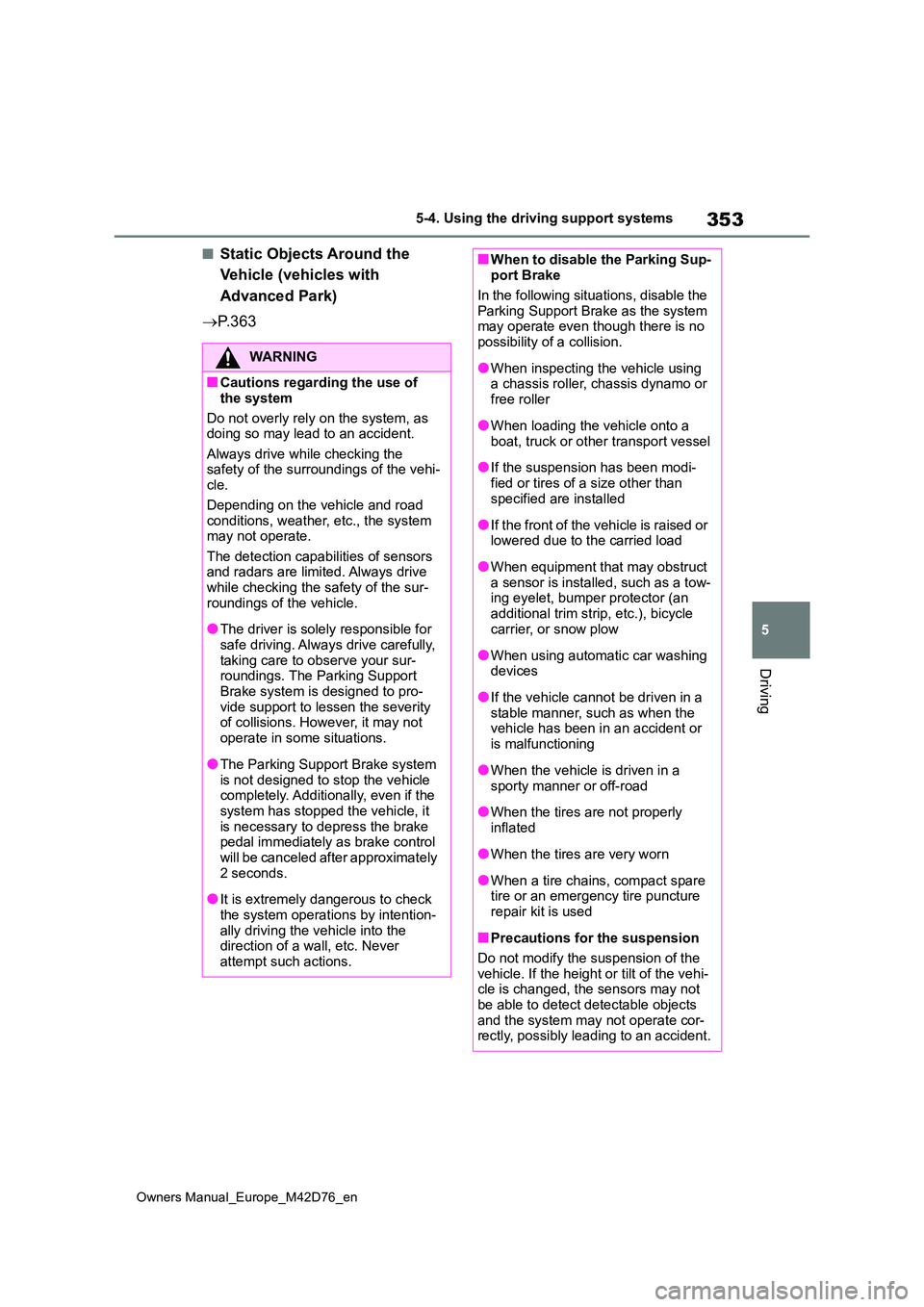
353
5
Owners Manual_Europe_M42D76_en
5-4. Using the driving support systems
Driving
■Static Objects Around the
Vehicle (vehicles with
Advanced Park)
P. 3 6 3
WARNING
■Cautions regarding the use of
the system
Do not overly rely on the system, as doing so may lead to an accident.
Always drive while checking the safety of the surroundings of the vehi-cle.
Depending on the vehicle and road conditions, weather, etc., the system may not operate.
The detection capabilities of sensors and radars are limited. Always drive while checking the safety of the sur-
roundings of the vehicle.
●The driver is solely responsible for
safe driving. Always drive carefully, taking care to observe your sur-roundings. The Parking Support
Brake system is designed to pro- vide support to lessen the severity of collisions. However, it may not
operate in some situations.
●The Parking Support Brake system
is not designed to stop the vehicle completely. Additionally, even if the system has stopped the vehicle, it
is necessary to depress the brake pedal immediately as brake control will be canceled after approximately
2 seconds.
●It is extremely dangerous to check
the system operations by intention- ally driving the vehicle into the direction of a wall, etc. Never
attempt such actions.
■When to disable the Parking Sup- port Brake
In the following situations, disable the
Parking Support Brake as the system may operate even though there is no possibility of a collision.
●When inspecting the vehicle using a chassis roller, chassis dynamo or
free roller
●When loading the vehicle onto a
boat, truck or other transport vessel
●If the suspension has been modi-
fied or tires of a size other than specified are installed
●If the front of the vehicle is raised or lowered due to the carried load
●When equipment that may obstruct a sensor is installed, such as a tow-ing eyelet, bumper protector (an
additional trim strip, etc.), bicycle carrier, or snow plow
●When using automatic car washing devices
●If the vehicle cannot be driven in a stable manner, such as when the vehicle has been in an accident or
is malfunctioning
●When the vehicle is driven in a
sporty manner or off-road
●When the tires are not properly
inflated
●When the tires are very worn
●When a tire chains, compact spare tire or an emergency tire puncture
repair kit is used
■Precautions for the suspension
Do not modify the suspension of the vehicle. If the height or tilt of the vehi-cle is changed, the sensors may not
be able to detect detectable objects and the system may not operate cor-rectly, possibly leading to an accident.
Page 358 of 674
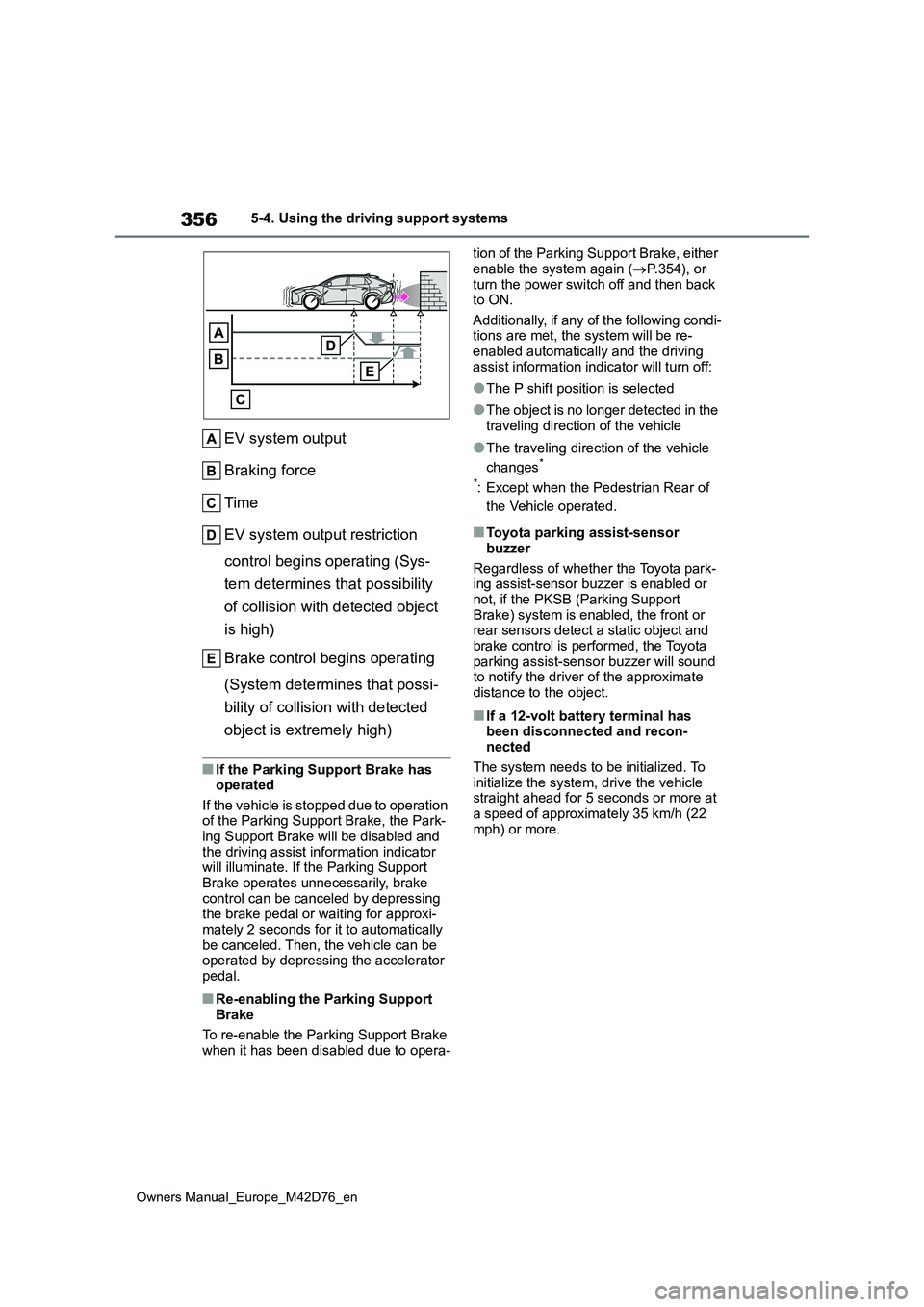
356
Owners Manual_Europe_M42D76_en
5-4. Using the driving support systems
EV system output
Braking force
Time
EV system output restriction
control begins operating (Sys-
tem determines that possibility
of collision with detected object
is high)
Brake control begins operating
(System determines that possi-
bility of collision with detected
object is extremely high)
■If the Parking Support Brake has operated
If the vehicle is stopped due to operation of the Parking Support Brake, the Park-ing Support Brake will be disabled and
the driving assist information indicator will illuminate. If the Parking Support Brake operates unnecessarily, brake
control can be canceled by depressing the brake pedal or waiting for approxi-mately 2 seconds for it to automatically
be canceled. Then, the vehicle can be operated by depressing the accelerator pedal.
■Re-enabling the Parking Support
Brake
To re-enable the Parking Support Brake when it has been disabled due to opera-
tion of the Parking Support Brake, either
enable the system again ( P.354), or turn the power switch off and then back to ON.
Additionally, if any of the following condi- tions are met, the system will be re-enabled automatically and the driving
assist information indicator will turn off:
●The P shift position is selected
●The object is no longer detected in the traveling direction of the vehicle
●The traveling direction of the vehicle
changes*
*: Except when the Pedestrian Rear of
the Vehicle operated.
■Toyota parking assist-sensor
buzzer
Regardless of whether the Toyota park- ing assist-sensor buzzer is enabled or
not, if the PKSB (Parking Support Brake) system is enabled, the front or rear sensors detect a static object and
brake control is performed, the Toyota parking assist-sensor buzzer will sound to notify the driver of the approximate
distance to the object.
■If a 12-volt battery terminal has been disconnected and recon-nected
The system needs to be initialized. To initialize the system, drive the vehicle straight ahead for 5 seconds or more at
a speed of approximately 35 km/h (22 mph) or more.
Page 359 of 674
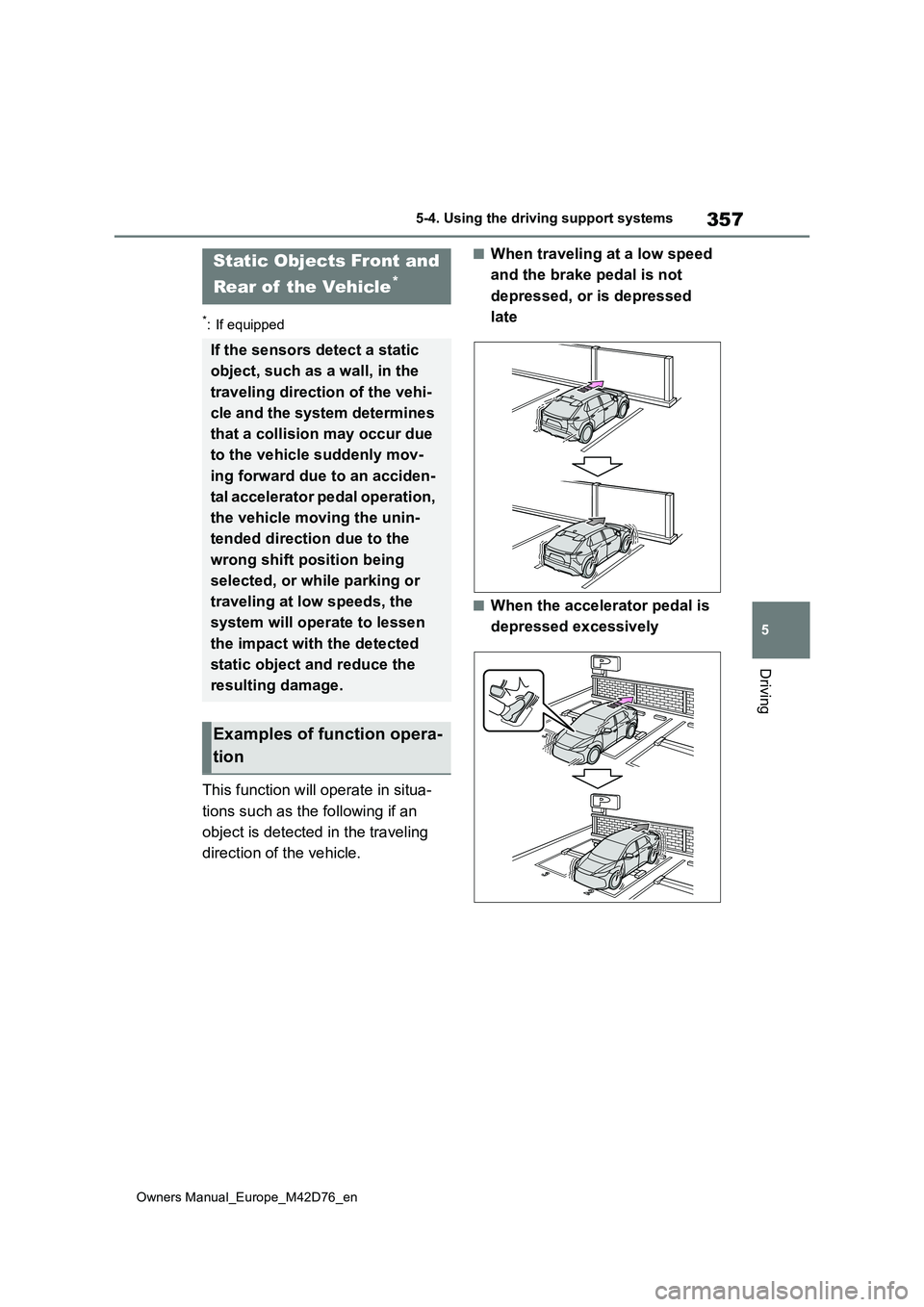
357
5
Owners Manual_Europe_M42D76_en
5-4. Using the driving support systems
Driving
*: If equipped
This function will operate in situa-
tions such as the following if an
object is detected in the traveling
direction of the vehicle.
■When traveling at a low speed
and the brake pedal is not
depressed, or is depressed
late
■When the accelerator pedal is
depressed excessively
Static Objects Front and
Rear of the Vehicle*
If the sensors detect a static
object, such as a wall, in the
traveling direction of the vehi-
cle and the system determines
that a collision may occur due
to the vehicle suddenly mov-
ing forward due to an acciden-
tal accelerator pedal operation,
the vehicle moving the unin-
tended direction due to the
wrong shift position being
selected, or while parking or
traveling at low speeds, the
system will operate to lessen
the impact with the detected
static object and reduce the
resulting damage.
Examples of function opera-
tion
Page 360 of 674

358
Owners Manual_Europe_M42D76_en
5-4. Using the driving support systems
■When the vehicle moves in the
unintended direction due to
the wrong shift position being
selected
P. 3 3 3
■The system will operate when
The function will operate when the driv-
ing assist information indicator is not illu- minated ( P.169, 519) and all of the following conditions are met:
●EV system output restriction control• The Parking Support Brake is
enabled.
• The vehicle speed is approximately 15
km/h (9 mph) or less. • There is a static object in the traveling direction of the vehicle and approxi-
mately 2 to 4 m (6 to 13 ft.) away. • The Parking Support Brake deter-mines that a stronger-than-normal
brake operation is necessary to avoid a collision.
●Brake control• EV system output restriction control is operating.
• The Parking Support Brake deter- mines that an immediate brake opera-tion is necessary to avoid a collision.
■The system will stop operating
when
The function will stop operating if any of the following conditions are met:
●EV system output restriction control• The Parking Support Brake is dis-
abled. • The system determines that the colli-sion has become avoidable with nor-
mal brake operation. • The static object is no longer approxi-mately 2 to 4 m (6 to 13 ft.) away from
the vehicle or in the traveling direction of the vehicle.
●Brake control• The Parking Support Brake is dis-abled.
• Approximately 2 seconds have elapsed since the vehicle was stopped by brake control.
• The brake pedal is depressed after the vehicle is stopped by brake con-trol.
• The static object is no longer approxi- mately 2 to 4 m (6 to 13 ft.) away from the vehicle or in the traveling direction
of the vehicle.
■Detection range
The detection range of the system dif- fers from the detection range of the
Toyota parking assist-sensor. ( P.337)
Therefore, even if the Toyota parking assist-sensor detects a static and pro-
vides a warning, the PKSB (Parking Support Brake) system may not start
Types of sensors
WARNING
■To ensure the system can oper-
ate properly
P. 3 3 4
■If the PKSB (Parking Support Brake) system operates unnec-essarily, such as at a railroad
crossing
P. 3 5 6
■Notes when washing the vehicle
P. 3 3 4
Page 361 of 674
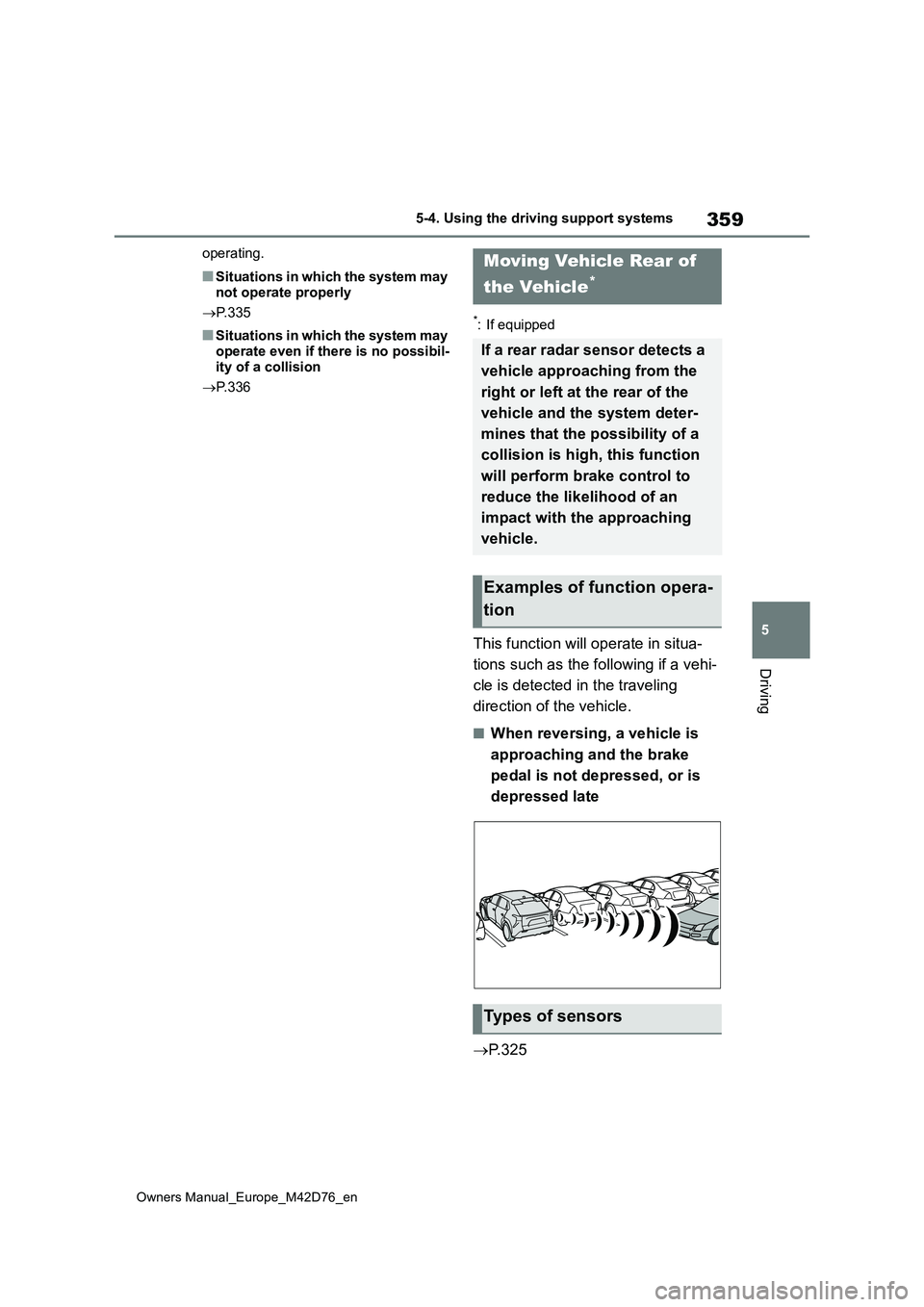
359
5
Owners Manual_Europe_M42D76_en
5-4. Using the driving support systems
Driving
operating.
■Situations in which the system may
not operate properly
P. 3 3 5
■Situations in which the system may operate even if there is no possibil-
ity of a collision
P. 3 3 6
*: If equipped
This function will operate in situa-
tions such as the following if a vehi-
cle is detected in the traveling
direction of the vehicle.
■When reversing, a vehicle is
approaching and the brake
pedal is not depressed, or is
depressed late
P. 3 2 5
Moving Vehicle Rear of
the Vehicle*
If a rear radar sensor detects a
vehicle approaching from the
right or left at the rear of the
vehicle and the system deter-
mines that the possibility of a
collision is high, this function
will perform brake control to
reduce the likelihood of an
impact with the approaching
vehicle.
Examples of function opera-
tion
Types of sensors
Page 363 of 674
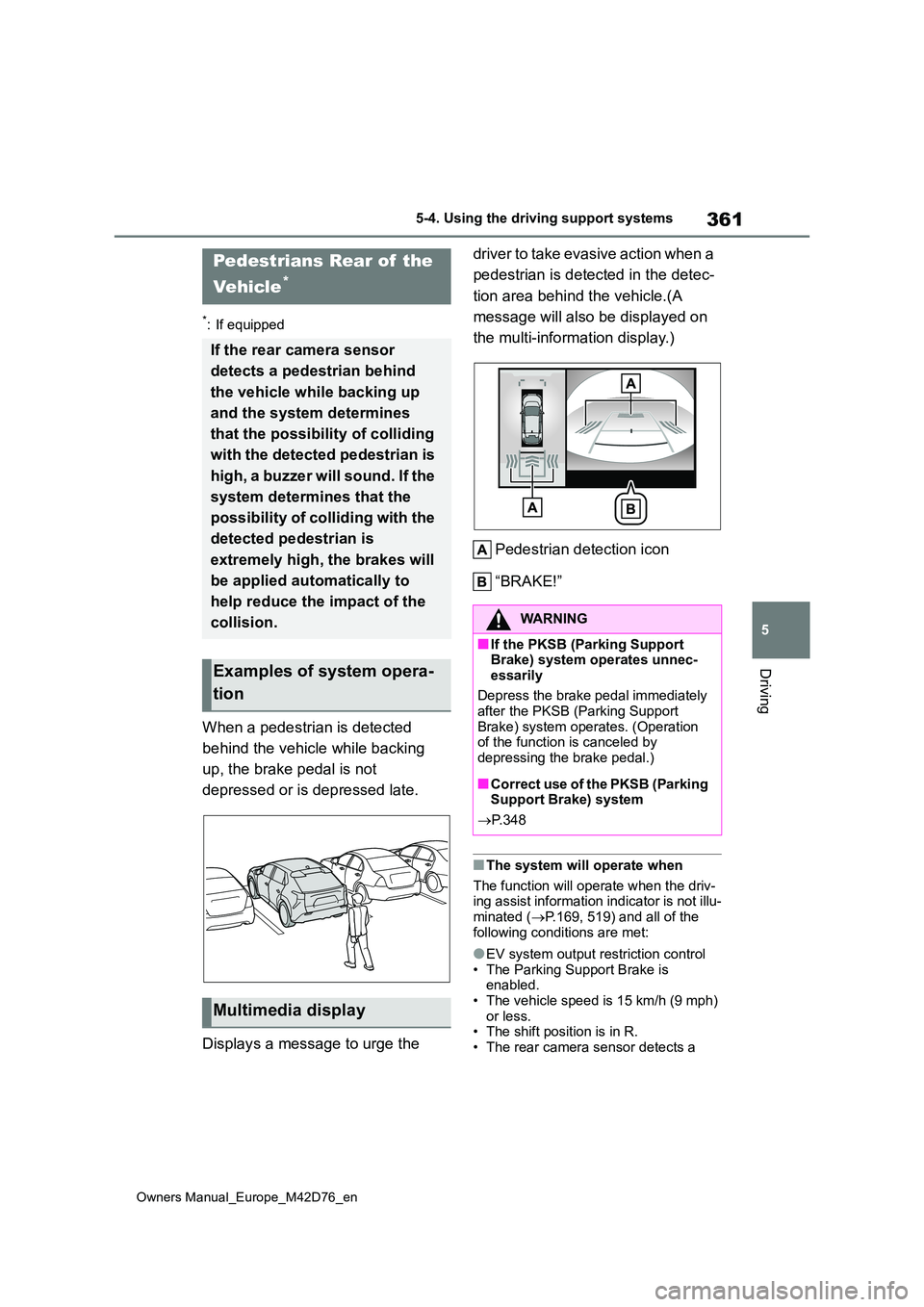
361
5
Owners Manual_Europe_M42D76_en
5-4. Using the driving support systems
Driving
*: If equipped
When a pedestrian is detected
behind the vehicle while backing
up, the brake pedal is not
depressed or is depressed late.
Displays a message to urge the
driver to take evasive action when a
pedestrian is detected in the detec-
tion area behind the vehicle.(A
message will also be displayed on
the multi-information display.)
Pedestrian detection icon
“BRAKE!”
■The system will operate when
The function will operate when the driv- ing assist information indicator is not illu-minated ( P.169, 519) and all of the
following conditions are met:
●EV system output restriction control
• The Parking Support Brake is enabled.• The vehicle speed is 15 km/h (9 mph)
or less. • The shift position is in R.
• The rear camera sensor detects a
Pedestrians Rear of the
Vehicle*
If the rear camera sensor
detects a pedestrian behind
the vehicle while backing up
and the system determines
that the possibility of colliding
with the detected pedestrian is
high, a buzzer will sound. If the
system determines that the
possibility of colliding with the
detected pedestrian is
extremely high, the brakes will
be applied automatically to
help reduce the impact of the
collision.
Examples of system opera-
tion
Multimedia display
WARNING
■If the PKSB (Parking Support Brake) system operates unnec-
essarily
Depress the brake pedal immediately after the PKSB (Parking Support
Brake) system operates. (Operation of the function is canceled by depressing the brake pedal.)
■Correct use of the PKSB (Parking Support Brake) system
P. 3 4 8
Page 365 of 674
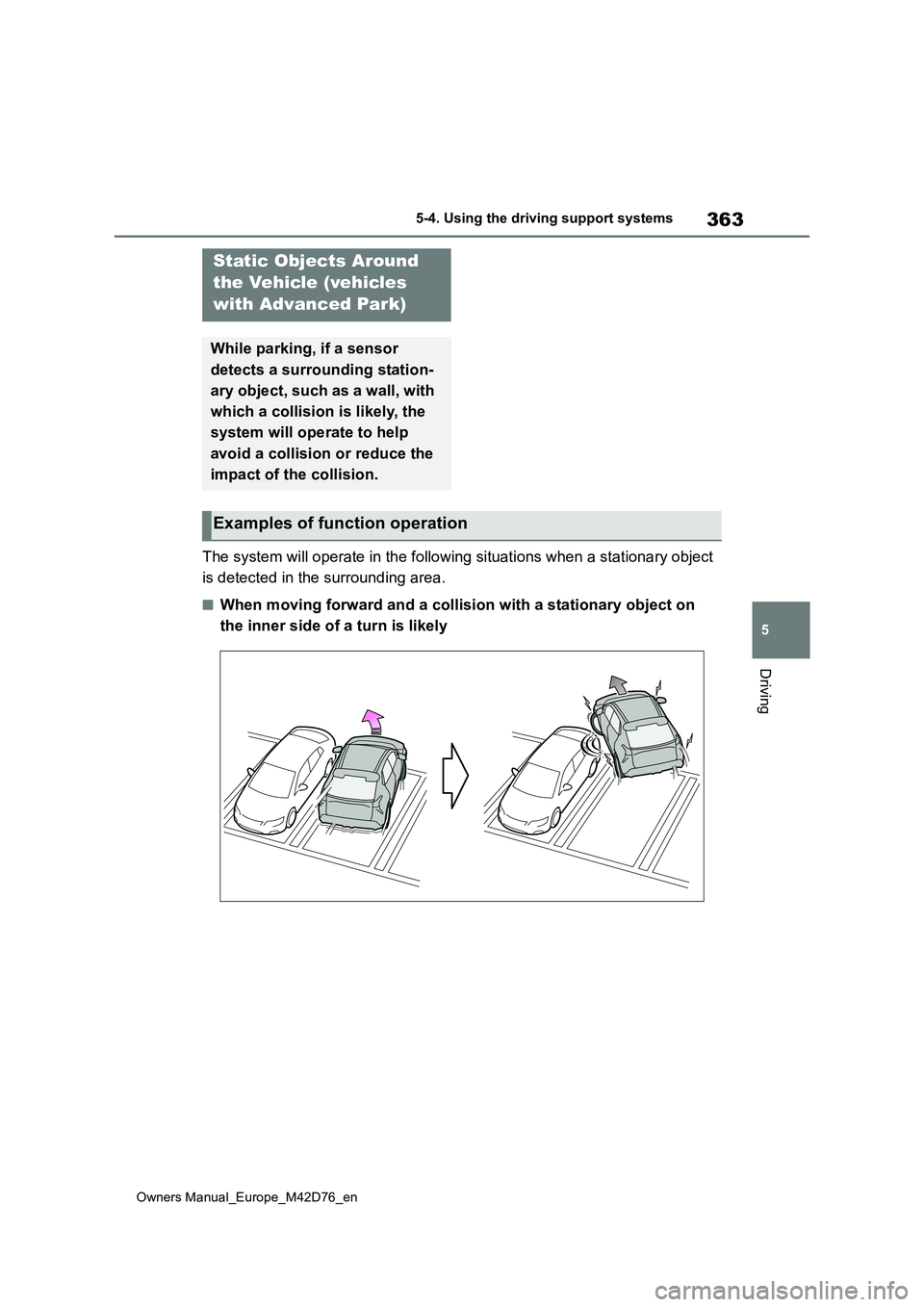
363
5
Owners Manual_Europe_M42D76_en
5-4. Using the driving support systems
Driving
The system will operate in the following situations when a stationary object
is detected in the surrounding area.
■When moving forward and a collision with a stationary object on
the inner side of a turn is likely
Static Objects Around
the Vehicle (vehicles
with Advanced Park)
While parking, if a sensor
detects a surrounding station-
ary object, such as a wall, with
which a collision is likely, the
system will operate to help
avoid a collision or reduce the
impact of the collision.
Examples of function operation
Page 366 of 674
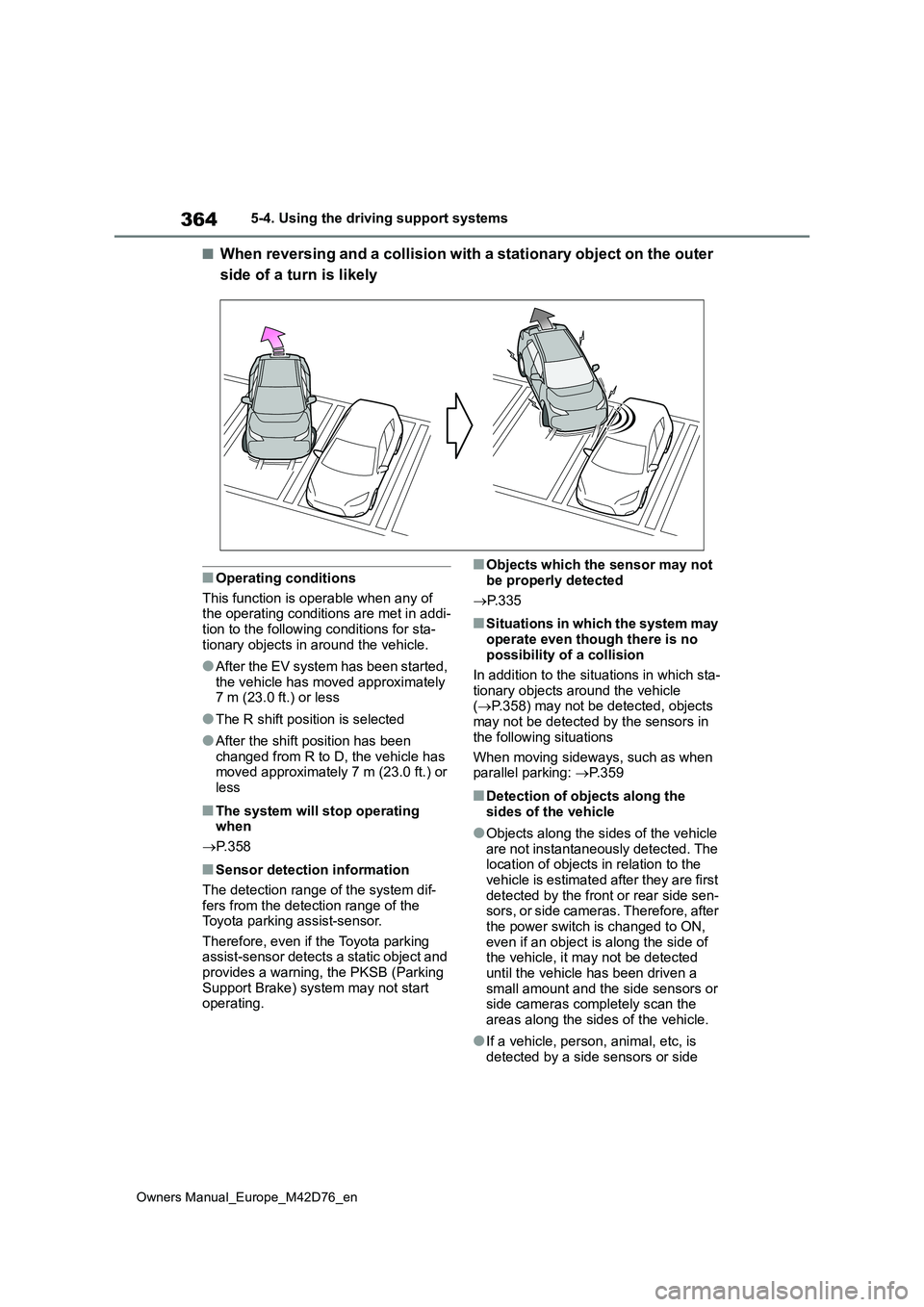
364
Owners Manual_Europe_M42D76_en
5-4. Using the driving support systems
■When reversing and a collision with a stationary object on the outer
side of a turn is likely
■Operating conditions
This function is operable when any of the operating conditions are met in addi-
tion to the following conditions for sta- tionary objects in around the vehicle.
●After the EV system has been started, the vehicle has moved approximately 7 m (23.0 ft.) or less
●The R shift position is selected
●After the shift position has been changed from R to D, the vehicle has moved approximately 7 m (23.0 ft.) or
less
■The system will stop operating when
P. 3 5 8
■Sensor detection information
The detection range of the system dif- fers from the detection range of the Toyota parking assist-sensor.
Therefore, even if the Toyota parking assist-sensor detects a static object and provides a warning, the PKSB (Parking
Support Brake) system may not start operating.
■Objects which the sensor may not be properly detected
P. 3 3 5
■Situations in which the system may
operate even though there is no possibility of a collision
In addition to the situations in which sta-
tionary objects around the vehicle ( P.358) may not be detected, objects may not be detected by the sensors in
the following situations
When moving sideways, such as when parallel parking: P.359
■Detection of objects along the
sides of the vehicle
●Objects along the sides of the vehicle
are not instantaneously detected. The location of objects in relation to the vehicle is estimated after they are first
detected by the front or rear side sen- sors, or side cameras. Therefore, after the power switch is changed to ON,
even if an object is along the side of the vehicle, it may not be detected until the vehicle has been driven a
small amount and the side sensors or side cameras completely scan the areas along the sides of the vehicle.
●If a vehicle, person, animal, etc, is detected by a side sensors or side